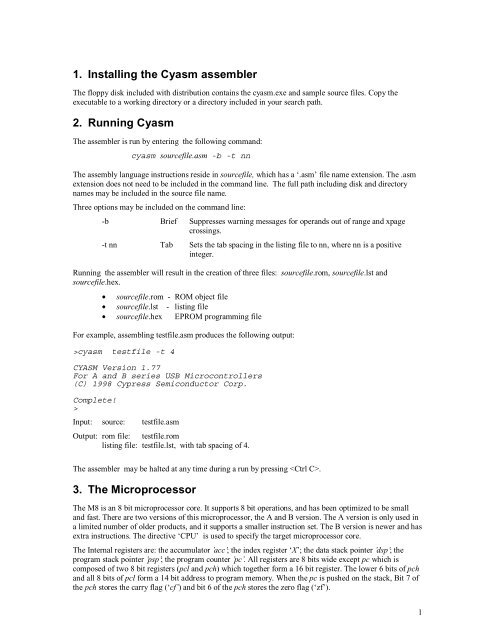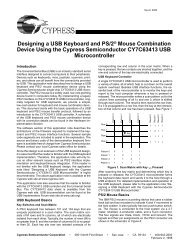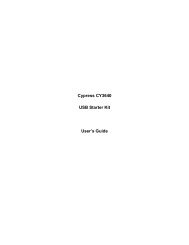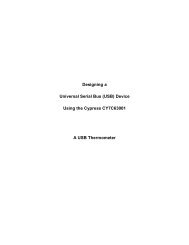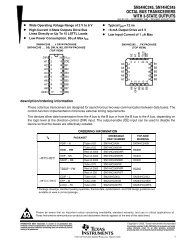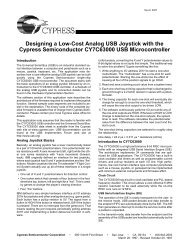CYASM ASSEMBLER USER'S GUIDE VERSION 1.77
CYASM ASSEMBLER USER'S GUIDE VERSION 1.77
CYASM ASSEMBLER USER'S GUIDE VERSION 1.77
You also want an ePaper? Increase the reach of your titles
YUMPU automatically turns print PDFs into web optimized ePapers that Google loves.
1. Installing the Cyasm assembler<br />
The floppy disk included with distribution contains the cyasm.exe and sample source files. Copy the<br />
executable to a working directory or a directory included in your search path.<br />
2. Running Cyasm<br />
The assembler is run by entering the following command:<br />
cyasm sourcefile.asm -b -t nn<br />
The assembly language instructions reside in sourcefile, which has a ‘.asm’ file name extension. The .asm<br />
extension does not need to be included in the command line. The full path including disk and directory<br />
names may be included in the source file name.<br />
Three options may be included on the command line:<br />
-b Brief Suppresses warning messages for operands out of range and xpage<br />
crossings.<br />
-t nn Tab Sets the tab spacing in the listing file to nn, where nn is a positive<br />
integer.<br />
Running the assembler will result in the creation of three files: sourcefile.rom, sourcefile.lst and<br />
sourcefile.hex.<br />
• sourcefile.rom - ROM object file<br />
• sourcefile.lst - listing file<br />
• sourcefile.hex EPROM programming file<br />
For example, assembling testfile.asm produces the following output:<br />
>cyasm testfile -t 4<br />
<strong>CYASM</strong> Version <strong>1.77</strong><br />
For A and B series USB Microcontrollers<br />
(C) 1998 Cypress Semiconductor Corp.<br />
Complete!<br />
><br />
Input: source: testfile.asm<br />
Output: rom file: testfile.rom<br />
listing file: testfile.lst, with tab spacing of 4.<br />
The assembler may be halted at any time during a run by pressing .<br />
3. The Microprocessor<br />
The M8 is an 8 bit microprocessor core. It supports 8 bit operations, and has been optimized to be small<br />
and fast. There are two versions of this microprocessor, the A and B version. The A version is only used in<br />
a limited number of older products, and it supports a smaller instruction set. The B version is newer and has<br />
extra instructions. The directive ‘CPU’ is used to specify the target microprocessor core.<br />
The Internal registers are: the accumulator ’acc’; the index register ‘X’; the data stack pointer ’dsp’; the<br />
program stack pointer ’psp’; the program counter ’pc’. All registers are 8 bits wide except pc which is<br />
composed of two 8 bit registers (pcl and pch) which together form a 16 bit register. The lower 6 bits of pch<br />
and all 8 bits of pcl form a 14 bit address to program memory. When the pc is pushed on the stack, Bit 7 of<br />
the pch stores the carry flag (‘cf’) and bit 6 of the pch stores the zero flag (‘zf’).<br />
1


